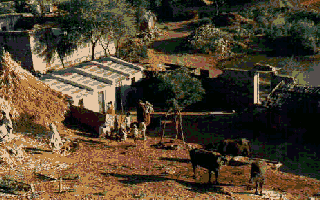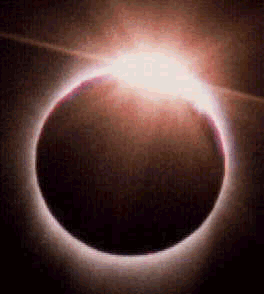
Why is the total solar eclipse exciting to view?
Why do we not see stars during the day? How did Shri Krishna create the illusion of sunset in advance of its scheduled time and enabled Arjun to kill Jayadratha? Does the Sun have structures outside its bright disk? If yes, when can we see them? Answers to these questions and many others of interest to astrophysicists can be found by observing the total solar eclipse.
The total solar eclipse, though a rare event, is looked forward to both by scientists and common man because it presents a grand visual spectacle whose description through words is as inadequate as telling a blind the aesthetic feelings experienced on watching a beautiful rainbow. Though being aware of such limitations, an attempt is made in the following to share the thrill of the total solar eclipse of October 24, 1995.
It is the morning after the Diwali. The sunrise over the Arawali Hills near Alwar in Rajasthan has been beautiful. Life is normal. There are no prior signals like unusual behaviour in me n and animals. What to talk of birds, even the local village folks are unaware of the celestial phenomenon yet to occur and are attending to their daily routine. Yet, the excitement of something extraordinary likely to happen is palpable.
We see a gathering of a group of Japanese amateur astronomers who have set up their cameras and instruments pointing toward the sky and are waiting in a paddy field with keen anticipation. We ourselves have created flutter in the life of the village Akbarpur.
Akbarpur

Akbarpur is like any other village of Rajasthan but has special significance for us as it falls within the line of totality from where the total solar eclipse will be visible. The village has a small hill providing an unobstructed view of the eastern sky. We also take our positions on the hill and admire the rural scenery on a cloudless beautiful October morning.
It is 7:24am. We are happy to see that the lunar disk has touched the line of sight to the Sun. It is the first contact. The solar eclipse has commenced.
Villagers view the eclipse

There is no noticeable change in the brightness of the day. We see through the specially coated visors that the Sunís disk has developed a small crescent. Now the villagers are also interested to see the Sun. We share our visors with them as they are safe for watching the Sun directly.
From this time onward there is common excitement. The life in the village has come to a stop, for adults and children alike are interested in seeing what we have come to see.
Waning Phase
Changes in the Sunís appearance that we see are like watching in one hour changes in the lunar phase that take place from the time of the full moon to the new moon. The intensity of the sunlight is gradually cut-off to less than one percent, yet the sky is bright. We feel that the temperature has dropped.
The crescent is waning fast and we realise that in few moments the solar disk will become completely dark. Before that happens we see a dazzling diamond ring.
Diamond Ring

The celestial diamond ring in its brilliance and lustre is majestic.On seeing this ring the proud owners of even the most expensive man-made pieces of jewellery may feel humbled to realise that what they possess are mere trinkets as they are a poor replica of the perfect ring owned by nature.
The grand finale of this drama is yet to come, but we do not have to wait for long. On the ground we see moving waves like ripples in a pond of water. These are called the shadow bands and are caused by the refraction of the changing light in the earthís atmosphere. Suddenly the sky turns dark and there is a loud sonic boom from the plane flying at supersonic speed following the eclipse.
Totality

It is the totality. We see a dazzling white cloud of light laced with golden colours surrounding the Sun. It is the solar corona. It is not seen except during the totality for the reason why we do not see the stars in day time. Mercury and Venus are now visible. There may be other bright stars visible to the naked eye. But there is so much to see in the two minutes of the totality.
Fascinating phenomena taking place in Sunís corona cannot be missed. There is a possibility of sighting even with unaided eyes shooting solar flares and prominences.
It is not surprising that birds are confused by the strange signals to return to their nest without having put in full-dayís activities. So was Jaydratha. He came out of the protective umbrella of the Kaurava warriors and was killed by Arjun like a sitting duck. We are awed by this celestial sight. It is glorious and exhilarating. We experience strange sensations, perhaps similar to what have been described in the visions of seers who have had divine glimpses. We feel as though we have been purified and are thankful for having been born. We wish that this sight will not end. But this is not to be.
Second Diamond Ring

As a parting gift diamond ring appears again.It is an indicator of return toward normalcy. The Moon has decided to clear its encroachment of the view of the Sun. On the upper edge of the Sunís disk a small bright crescent appears.
Waxing Phase
The crescent begins to grow in size. It is like the fast playback of the waxing of the phases from the new moon to the full moon. The sky is gradually restored to full daylight. The solar eclipse ended by 10am.
Total solar eclipse are indeed rare events. From any given place on the Earth they can be seen once in about 360 years. The next total solar eclipse visible from India will be on 11 August 1999. All those of us who were privileged to witness the total solar eclipse of October 24, 1995 will carry with us a feeling of reverence for nature and also indelible memories worth sharing with our grand children.
You may like to send me your comments on this article or may like to get additional information from me. My address is given at the bottom of the Professor Maheshwari's HOMEPAGE.